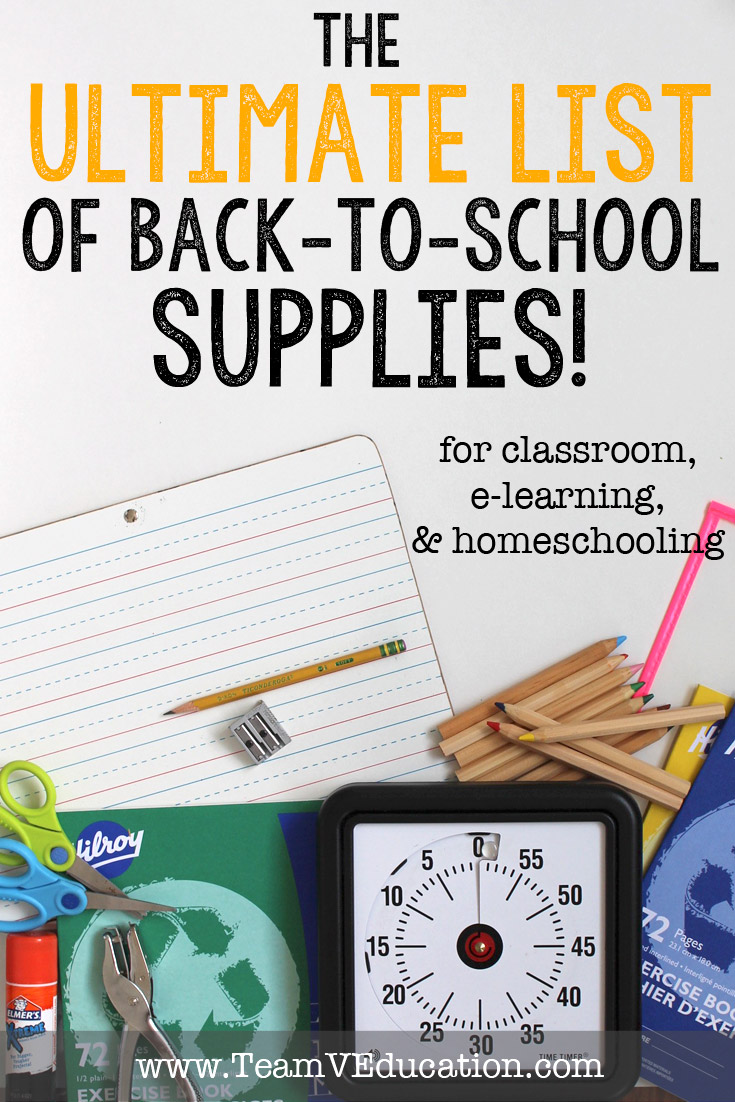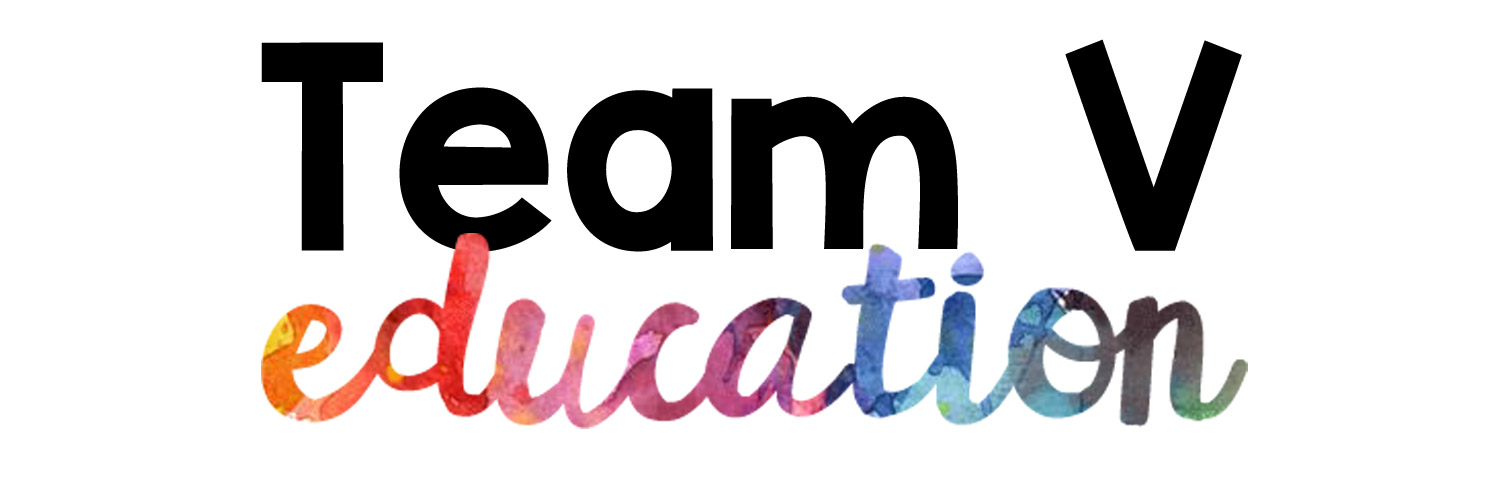The Ultimate List of Back-to-School Supplies for E-Learning and Homeschooling
As online learning (“e-learning”) continues and becomes more popular, many families may be looking for resources to make learning at home easier and more efficient. We’ve provided the ultimate list of back-to-school supplies for e-learning and homeschooling. Whether your child(ren) is learning in the classroom, online, or at home, you’ll find useful materials here.
Related: Eclectic Kindergarten Curriculum that Supports Child-Led Learning
Here at Team V Education, we have spent years as educators both in the classroom and at home, and have plenty of experience in regards to what works, and how to organize your learning environment for success.
Together we have compiled a list of tools and materials that we either have personal experience using, or would consider purchasing for our own family. We hope that this will help you along in your journey.
Remember to always consider the needs of your own child, and to plan accordingly. Our belief is that less is more.
A simple system together with your favourite teaching tools will keep your home organized and easy to navigate.
(Team V Education is a participant of the Amazon Services LLC Associates Program. As an affiliate, we earn advertising fees from qualifying purchases at no extra cost to our readers. Thank you for supporting Team V Education!)

Back-to-School Supplies for E-Learning and Homeschooling
For your convenience, this post contains affiliate links. As an Amazon associate, I earn from qualifying purchases.
The following categories provide possible materials that benefit e-learning and homeschooling. From blue-light blocking glasses to a simple pencil (we share our favourite!), you are bound to find exactly what you need.
We broke this information into three separate categories: “e-Learning Tech Resources,” “Home Learning Essentials,” and “Scheduling/Organizational Tools.” Each item connects you to Amazon, from which we purchase many of our own school supplies.
E-Learning Tech Resources
Blue Light Blocking Glasses
Blue light has been shown to cause damage to eyes, and with increased time devoted to devices, we need increased measures to protect our children from blue light emissions.
Headphones
With multiple children learning from home, you may not want to hear multiple lessons happening at the same time! Remember to check that the volume is at a safe level for your child.
Earmuffs
Even if a child is not listening to a lesson, they may need to block out noise in the home to help them focus.
Laptop/Chromebook
Coach Vanderlee enjoys using the Chromebook for his e-learning courses. It connects straight to Google docs (which automatically saves children’s work), is easy to use and navigate, and saves login information. Oftentimes, this will be what a student is used to in their classroom. Lastly, the price point is reasonable for most families. (Note: Many school boards in our area have supported families who struggle to provide technology at home. Be sure to connect with your school board if you require assistance.)
Mouse (Wireless)
A mouse is so much faster than using a computer touchpad. If you prefer wireless, go for it!
Ethernet Cable/Splitter
Use an Ethernet cable to connect directly into your splitter or modem. This can help guarantee faster speeds compared to wireless. Use a splitter to connect multiple devices simultaneously.
Ethernet Switch
An Ethernet switch helps to keep a strong signal across devices. (Often when you connect multiple devices to one modem, the signal is weakened across the devices. The switch prevents this from happening.) We found this to be helpful as we navigated e-learning at home.
Printer
Because sometimes you just need to print it off and do the work by hand! We have an old Brother printer that we have used for years and enjoy; however, here are some other reasonable options. Consider your personal needs: colour printing, wireless printing, refillable ink cartridges. These are several things to consider when choosing a printer that best suits your needs at home.
Printer Paper
We use different types of paper for various uses. A simple “multipurpose” paper is perfect for every day use (typically listed at 20lb. paper). 24lb. paper is fantastic for projects or papers that will get more use – it of course feels thicker or more sturdy. Two different types of heavy “cardstock” paper can be used for creating quiz cards and other projects at home. 65lb is the standard “cardstock” weight, while 100lb is much heavier. We sometimes use the heavier paper for materials that need to stand the test of time (i.e. be used by all five of our children). Coloured cardstock is our go-to for labelling binders for each of our children (each child has a separate colour), for drawing attention to certain topics, for projects, and more. Lastly, Kraft cardstock is a great natural-looking alternative to coloured paper when your main learning environment is at the hub of your home and you want to keep the ‘flashy’ classroom feel to a minimum!
Laminator
If you have activity cards or other resources that need to be used again and again, a laminator is helpful in preserving these items.
Laminating Sheets
Be sure to purchase the correct sheets for your laminating machine. We’ve shown the Scotch Thermal Laminating pouches here (8.5″x11″ size). Your machine may require something different.

Scotch Thermal Laminating Pouches
Paper Cutter
We’re a family that loves creative arts. Our paper cutter has a permanent spot on top of the fridge (out of the way of little hands!), and is used frequently (by mom or dad). We personally use an “X-ACTO” paper cutter in our home; however, we’ve shared two other options that seem appropriate for the requirements of home education.
Home Learning Essentials
Pencils
Ticonderoga Pencils are Team V’s absolute favourite pencils to use. We prefer smaller “golf” pencils for smaller hands!
Pencil Sharpeners
We prefer an old-school wall-mount sharpener at home. We’ve also used electric sharpeners in our classrooms, but found that it became more of a toy than a tool, and pencils were sharpened down to a nub in no time! On the go, a hand sharpener is cheap and easy.
Binders/Dividers
Keep everything organized by subject. We like to purchase high quality dividers so they can be used year after year.
Sheet Protectors
These can be used to hold key learning pages that you want to reference often or even as a dry erase page in a pinch. We like to put our math pages in here so that they can be used again and again, and for all the kids.
Binders
Various binders can be used depending on your preference. Zippered binders keep everything contained if your child happens to be carting their work from place to place. Binders with clear fronts allow you to label for multiple children and keep things organized at home. Lastly, Kraft binders are for those who like to keep things ‘pretty.’
When choosing a binder, consider the subjects it will hold and how large it needs to be for your child’s needs. We often use 1″ binders; however, 2″ may be better if you intend to include many subjects.
Dry Erase Board & Markers
Along with using the markers on the sheet protectors, using them on a board to give better visual instruction for parent and teacher is another way to help your child see multiple ways to complete an activity. This also breaks up the monotony of paperwork. (Bonus: This also might help to take away the anxiety of getting a question wrong, as they can work through the problem before recording their answer on the hardcopy for submission.)
Folders/Duotangs
For smaller projects, or for containing daily work, folders and duotangs might be a great way to organize children’s work at home.
Markers, Crayons, Coloured Pencils, and Watercolour Paints
Make sure you have your favourite art supplies on hand for projects and any child-led learning experiences.
Related: 14 Brilliant Books to Inspire Creativity
Pencil Cases
Contain all of the loose writing instruments with a pencil case that matches your child’s personality.
Highlighters
These can be used to help a student to identify the main message in a piece of writing, to highlight main ideas, or numbers in a math problem. You can also highlight mistakes for them to fix. (Bonus: We sometimes use a different colour for each child to highlight items on a calendar.)
Glue Sticks/Scissors
Perfect for supporting fine motor skills and completing various school assignments. Have glue and scissors closeby.
Notebooks/Lined Paper
In our experience where students are required to submit work electronically, it is often easier to have them complete it by hand in a notebook or on lined paper, and then email/submit scanned images for their teacher to grade.
Index Cards
These are helpful in creating vocabulary cards or fast math quiz cards. Use together with the “Jolly Phonics” curriculum (or another phonics curriculum) to make a list of words that young children can sound out as they are learning to read. Lastly, we often combine the index cards with a set of slip rings and a hole punch for a fast learning activity that can be carried along.
Book Binder Rings
These rings are helpful for keeping note cards or quiz cards contained. We’ve used them to hold together a certain times table that our child is working to memorize, or a series of letter sounds that need to be learned. The possibilities are endless.
Hole Punch
In addition to the rings, a hole punch is helpful for creating nice, neat holes in the corner of your cards.
Scheduling/Organizational Tools
Visual Timer
We use timers for everything: focused work time, ‘mama needs to work’ time, quiet time, music lessons, etc.
Our absolute favourite timer is the “Time Timer.” It provides a visual guide that children can see: the red timed section slowly fades away as the timer reaches the end. It also has the option of an alarm that can be turned on or off depending on your needs. Other timer options exist, which we’ve shared here; however, the “Time Timer” is our top pick.
Kids Day Planner
Keep up to date with classroom requirements and deadlines and teach organizational skills and time management. A personal day planner is a great way to support learning at home. Both the parent and child can provide entries and follow along. Oftentimes schools provide these.
Sticky Notes/Tabs
Sticky notes are great to identify where a child left off in their workbook, to make notes while reading a novel, notes of encouragement, or even a to-do checklist for the day.
Clipboards
We enjoy these for bringing work outside so that nothing blows away!
Dry Erase Sleeves
These are similar to using sheet protectors, but more sturdy. A dry erase sleeve is a great way to design a daily to-do (e.g. make bed, brush hair, practice piano, etc.) and have kids use dry erase markers to check off when they’ve completed their work.

Wall/Desktop Calendar
This is a good tool for parents to create a visual outline of upcoming deadlines and making a plan to stay on track.
Storage Cart
We enjoy our cart to contain our children’s binders and notebooks. You can also include other teaching tools or handwriting tools. The fact that it can be wheeled around the house is helpful for when you want to work in different areas.






































































































Pingback: Eclectic Kindergarten Curriculum that Supports Child-Led Learning - Team V Education